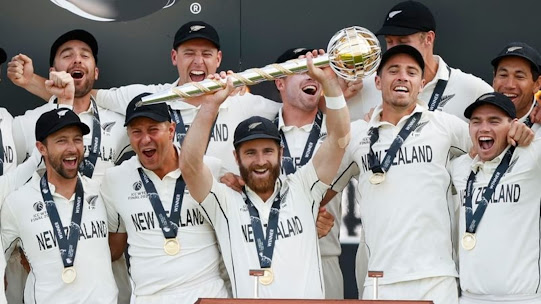New Zealand's Historic Win: A Deep Dive into India’s 2024 Test Series Defeat
न्यूज़ीलैंड की ऐतिहासिक जीत: भारत की 2024 टेस्ट श्रृंखला हार पर एक गहन विश्लेषण
Under the clear skies of Pune, an empire creaked and collapsed. India lost their first home Test series in 12 years, ending an 18-game winning streak and heralding the symbolic end of a golden era.
The impregnable base had repelled other great captains, including Australia's Pat Cummins and England's Ben Stokes, but not New Zealand's Tom Latham, who was only a fortnight into his tenure. He is currently the first captain of his country to win a series in India. He can't be blamed for feeling like his countrymen Edmund Hillary, the first man to climb Mount Everest.
In his team's moment of glory, Latham, true to the spirit of New Zealand sports, did not forget his fellow summit victors. "I'm quite proud to be up here.
The target of 359 the visitors set for India was steep, and they fell short by 113 runs. As New Zealand rejoice the sweetest of their triumphs, India are left reeling with uncomfortable questions. Both long-term and short-term.
The most immediate would be whether the team they have chosen for the Australia tour, more or less the same squad as this series, are competent enough to pose a strong challenge to the Australians, perked up to atone for the defeat last time. Whether they have the quality, gumption and composure to return home unscathed.
But India’s captain Rohit Sharma, while admitting that they needed to bear collective blame and delve into their failings, asserted that they wouldn’t seek desperate measures. “We have won so many games in the last 12 years, on all kinds of wickets. I think we ourselves had created an impression that we can’t lose at home. But the opposition team is also studying us and sometimes they do things better than us. We didn’t bat well in 2-3 innings and that happens,” he said.
But a broader concern is the team’s identity and direction. Is it a pre-transition team, or a transitioning one? If so, are some of the veterans past their prime? Rohit Sharma averaged 15; Virat Kohli a marginally better 22
But before the selectors discuss their long-term viability, they should ponder whether the men they have earmarked as the future of Indian batting are adequate enough or ready yet to withstand the pressures of international cricket.
It’s time for deep introspection in Indian cricket. For this was not an anomalous result, India were out-played and out-thought in their own conditions. In the first Test at Bengaluru, they were ambushed on a green-top. In Pune, they were stumped on a turner. The technique of batsmen against both the moving and seaming ball were exposed.
The veteran spin pair of Ravichandran Ashwin and Ravindra Jadeja too endured a fallow series. In two Tests, they have just 12 wickets between them. Contrast this with Kiwi left-arm spinner Mitchell Santner, who had 13 scalps in one Test. Though wholesale changes would be knee-jerk, it was a rude reminder that India’s selectors and team management need to flesh out succession plans.
But Sharma said there wouldn’t be a public crucifixion. “We will have a couple of chats with the guys… there is no need for a team talk… tell them that you should have done this or that. They know what they have done well and what they have not,” he said
After being second best for the third straight day, India’s defeat seemed inevitable, but hope fluttered when Yashasvi Jaiswal launched a stinging counterattack for a 65-balled 77. Just the second ball he faced, he swiped Tim Southee for a six and continued the charge for nearly an hour past lunch.
He defied the threats of the spinners and the tantrums of the surface admirably. He cut and drove, pulled and swept them into submission, as India breezed past 100 in 16 overs, stirring memories of Virender Sehwag in the historic chase of 387 against England in Chepauk (2008) soon after the Mumbai blasts. But the devils of the surface inevitably caught up with him, as a Santner ball spun away from him, brushing the edge in the journey to the first slip.
Hope still dangled, as the finest Indian batsman of the generation Virat Kohli was still at the crease. For a decade-and-a-half, he has been the torchbearer of Indian batting, the hope of a billion souls. In his 40-ball stay, he looked defiant and purposeful, resolved to produce another timeless masterpiece. The wrists whirled, as he struck his first boundary, whipping the ball of his legs with characteristic gusto.
But he tried to clip the ball off his legs, a staple shot of his, missed the ball and was hit on the pads. When the umpire raised his index finger skywards, there was a sense of doom encroaching the arena. He reviewed, only for the DRS to uphold the umpire’s decision. He looked desolate as he staggered back, both in disbelief and agony that he would be on the losing side of a Test series at home for just the second time in his career.
When India lost their last home series, against England in 2012, Kohli was an aggresive youngster settling himself into the side. Then he was the future, and now he could, perhaps, feel he is the past.
That seven-over phase, bookended by the exits of Jaiswal and Kohli, snuffed out the outside prospects of a Pune miracle. Five balls after Jaiswal’s departure, a stunning throw from Santner caught Rishabh Pant, the team’s miracle man, short on the crease. And then Kohli departed, which felt like the quiet end of an era of home domination.








No comments:
Post a Comment